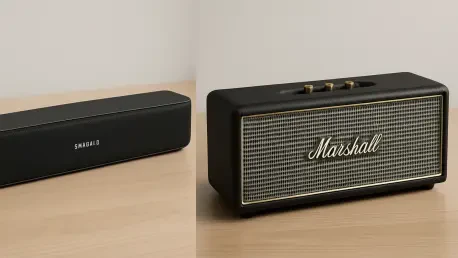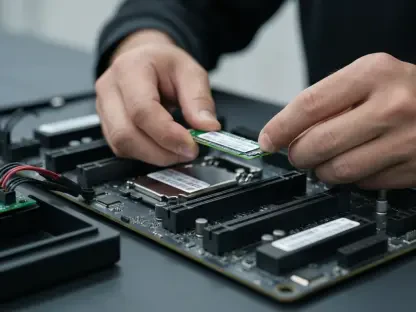In the world of home audio equipment, soundbars have emerged as a popular choice for consumers seeking enhanced sound quality without the clutter of traditional speaker systems. As audio technology continues to evolve, the decision-making process for consumers becomes increasingly complex, involving considerations of design, audio performance, and lifestyle compatibility. Two prominent contenders in the soundbar arena are Samsung and Marshall, each offering unique features that cater to different consumer needs. On one hand, Samsung’s HW-Q800D soundbar is lauded for its powerful audio delivery and immersive Dolby Atmos effects, making it an ideal choice for movie enthusiasts seeking a cinema-like experience at home. On the other hand, Marshall’s Heston 120 soundbar stands out with its refined aesthetic design and musical proficiency, appealing to consumers who prioritize style and musical clarity over raw sound power.
The Multi-Box Approach
The Samsung HW-Q800D soundbar represents a traditional multi-box setup that combines a soundbar with a separate subwoofer to deliver robust sound dynamics, including deep bass and clear dialogue. This setup is favored by those who have the space and desire for a more complex audio system capable of producing powerful cinema sound. Featuring a total output power of 360 watts, the HW-Q800D excels in action-packed scenes and dramatic soundscapes, thanks to its Dolby Atmos technology that creates an enveloping sound field. However, its performance comes with potential drawbacks, particularly for apartment dwellers concerned about noise transmission to neighbors below, which is a common issue with powerful subwoofers. The physical presence of the subwoofer also requires additional space and can impact aesthetic considerations within a living environment.
Samsung’s approach to home audio largely reflects a commitment to powerful sound setups that cater to audiophiles and home theater enthusiasts. Yet, it may not suit everyone, especially those who prefer minimalist designs or live in environments where noise levels can become problematic. While the HW-Q800D delivers exceptional sound quality and is particularly well-suited for larger, dedicated media rooms, it also highlights potential limitations in terms of spatial practicality and aesthetic simplicity. Beyond raw power, consumers may find themselves weighing the benefits of powerful audio against potential disturbances to surrounding residents and aesthetic disruptions in more compact living spaces. The dynamic capabilities of the HW-Q800D illustrate why some users might prioritize surround sound effects and overall loudness capabilities, but it also underscores why others may seek alternative solutions that focus on audio quality without overpowering outputs.
The All-in-One Solution
Marshall’s Heston 120 soundbar offers a contrasting approach by integrating audio components into a singular design, aiming to balance sound quality with aesthetic appeal and spatial practicality. This design not only saves space but enhances the overall aesthetic of a living room, especially appealing to those who appreciate the iconic look of Marshall’s products. The Heston 120 offers 150 watts of output power, sufficient for everyday musical enjoyment and casual sound experiences without the risk of disturbing neighbors. Though it might not match the booming bass offered by standalone subwoofer setups, its musical clarity and refined soundscape are highly commendable. These aspects resonate particularly with those who enjoy music-focused sound setups complemented by sleek design sensibilities.
Marshall’s choice to innovate through design reflects an industry trend moving toward the integration of technology with home décor. The Heston 120’s visual appeal, characterized by elegant features like knurled metal control dials and a golden logo, demonstrates how consumer decisions can be driven by both technological requirements and personal preferences in design. This marks a shift toward audio solutions that serve functional and aesthetic purposes, establishing Marshall as a frontrunner for consumers seeking simplicity without sacrificing audio depth or elegance. While it may not deliver the immersive soundstage found in Dolby Atmos setups, the Heston 120 provides an admirable musical experience that still captivates listeners, especially favoring those who value musical fidelity and vibrant design over sheer sound power.
Music vs. Cinema
From a performance perspective, the comparison between Samsung and Marshall soundbars reveals distinct strengths, aligned with the different needs of music lovers and cinema fans. The Samsung HW-Q800D excels in cinematic contexts, delivering dynamic soundscapes and the drama needed for movies and action-packed visuals. Its ability to immerse the viewer within atmosphere-heavy scenes is impressive, making it a solid choice for dedicating time to flicks while providing profound sound depth during quieter moments. Competence in delivering clear dialogue and intricate sound details enhances the cinematic experience but might overshadow the need for musical clarity.
Conversely, the Marshall Heston 120 stands out in musical applications, offering expansive sound textures and enhanced atmospheric audio effects. For those who prioritize music, the Heston 120 emerges as an attractive choice, illustrating its strength in handling diverse musical genres and individual notes with precision. This musical expertise is anchored in Marshall’s rich history of delivering meticulous sound quality and aligns seamlessly with their aesthetic legacy. For frequent music listeners and casual viewers of non-action-oriented video content, the Heston 120 allows for sonic enjoyment that is balanced and nuanced, catering to those with limited space and specific design preferences conducive to urban living standards.
Moving Forward
The Samsung HW-Q800D soundbar offers a traditional multi-box setup, pairing a soundbar with a separate subwoofer to deliver rich sound dynamics, featuring deep bass and clear dialogue. This choice appeals to those with the space and desire for advanced audio systems capable of cinema-quality sound. The HW-Q800D boasts 360 watts of power, shining in action scenes and dramatic soundscapes, thanks to Dolby Atmos technology that crafts an immersive sound field. Nevertheless, this performance may have downsides, especially for apartment dwellers concerned about noise reaching neighbors below—a frequent issue with powerful subwoofers. The subwoofer requires extra space, impacting aesthetic considerations within a home. Samsung’s audio approach showcases a focus on robust sound systems for audiophiles and home theater buffs, but it might not fit minimalist tastes or noise-sensitive environments. The HW-Q800D excels in larger media rooms, but consumers might weigh audio power against neighbor disturbances and space aesthetics, seeking solutions prioritizing quality over sheer loudness.









